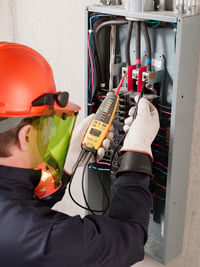
There's a lot at stake when electric utility field service representatives turn the electric power on or off. Their safety, and that of their customers, comes first. So each time they remove or install an electric meter for one of 300,000 customers, field reps for this Electric Co. test the meter socket for voltage.
"My guys aren't electricians, they are strictly field service employees," said the supervisor of field service and collections. "They use a tester to determine if voltages are correct, and if there's load being drawn from inside the house when they restore service. They're also trying to determine if there's tampering."
The company won't activate service if a device in the home is drawing current. The load could be an appliance, such as a hair dryer, heater or power tool, that would cause a hazard or even start a fire if left on unattended. Another problem is tampering with electric service, which involves rewiring to bypass the meter and get power for free. Of course that's illegal, but a greater concern is the fire and shock hazard tampering with circuitry can cause for residents and utility workers.
In the past, the service representatives used a solenoid-based electrical tester or "wiggie" device to detect voltage and load (see sidebar). But recently, the supervisor had them try a new tool for the job, the safety-rated Fluke T+PRO Electrical Tester. It all started with an incident that could have had tragic consequences: A service rep tested a meter socket, but the solenoid tester in use did not detect that there was continuity present. Someone had tampered with the service. The continuity caused a short.
"Our safety department got involved," the supervisor said, "and they told us the solenoid-based tester was old technology and not reliable." As they looked for a replacement tool, the team determined that the digital multimeters used elsewhere in the company were too sensitive and had more features than the service reps needed. Then they heard about a new device, the safety-rated Fluke T+PRO Electrical Tester, that was specifically designed to do the job of the old solenoid-based testers, but more accurately and safely.
The Fluke T+PRO tester is safety rated for use in IEC CAT IV 600 V (including outside facilities, service entrance and electric meters) and CAT III 1000 V settings and complies with the National Fire Protection Association (NFPA) standard 70E when used properly per Article 110.9. It looked like it could meet the team's need for a safety-rated test tool of compact size, capable of testing meter sockets without picking up stray or "ghost" voltage.
When they tested the Fluke T+PRO on the job, the field service team liked its ease of use and multiple signaling methods (LCD, LED, sound and vibration) and its built-in light, and felt the unit was built tough enough for daily industrial use. They also appreciated its added features for resistance, continuity and GFCI testing. One rep commented that the Fluke tool detected a small load - a transistor radio left on - that the solenoid tester did not pick up. Another group of employees, the meter electricians who actually test electric meter function, liked the tool's ability to test all three power phases.
The team also had suggestions for the Fluke design engineers, such as larger buttons for gloved hands and a battery life indicator. The T+PRO test leads also took some getting used to, but the unit does come with a velcro test lead wrap to help keep them under control.
The Fluke T+PRO passed the field tests, and the utility is adding the tool as a standard to replace all of the old solenoid-based testers. "These devices worked perfectly," the supervisor said. "They do what they are intended to do and they have very nice features. We're going to bring them in as a regular stock item in our warehouse," he said. And, in addition to the 25 field service representatives, and the meter electricians, they anticipate that the overhead and underground crews too will adopt the Fluke T+PRO.